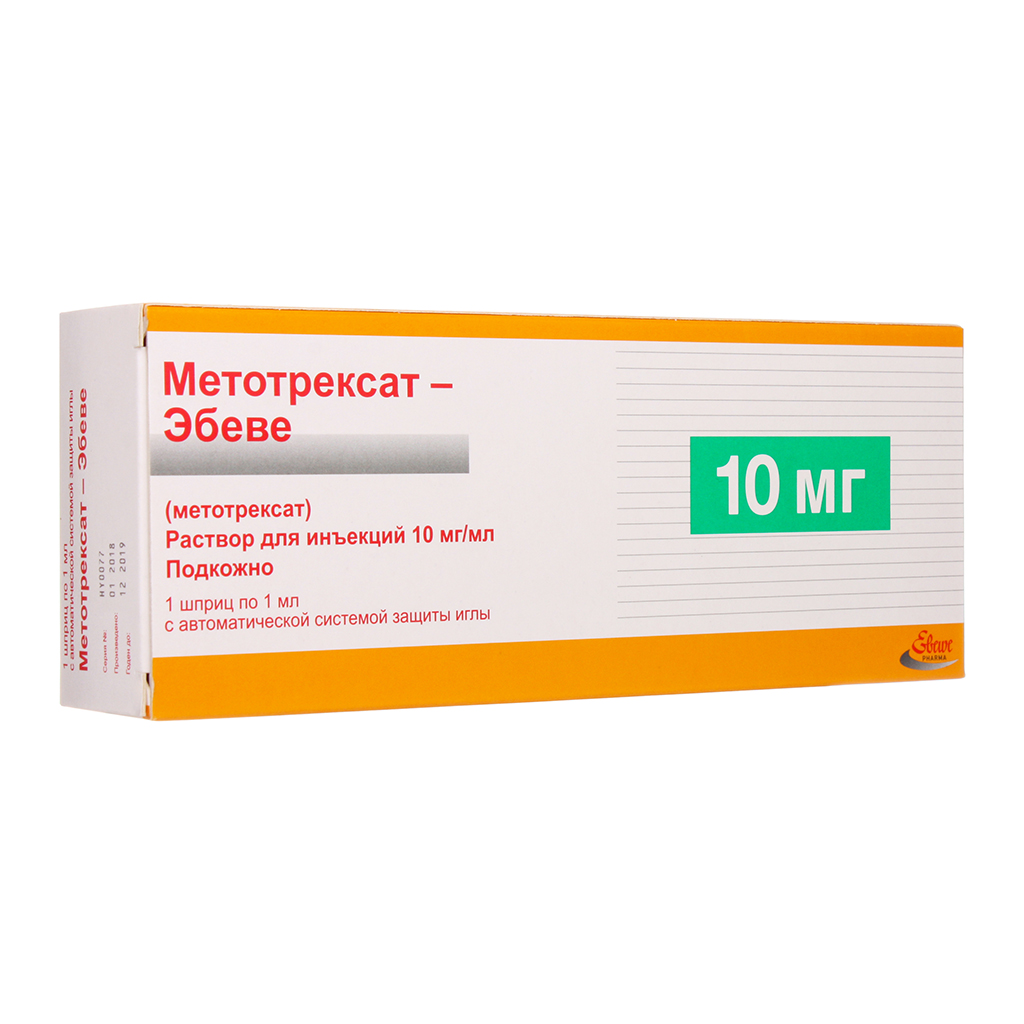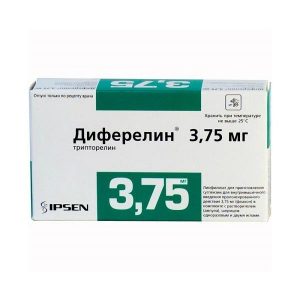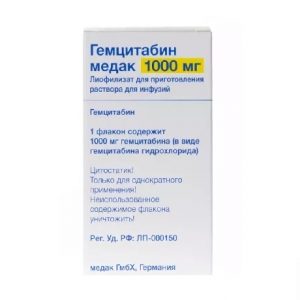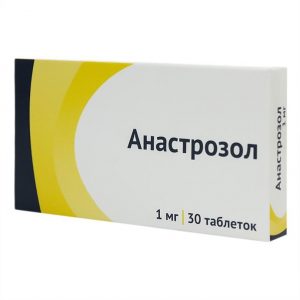Description
Pharmacological action
Pharmacodynamics
Antitumor, cytostatic agent of the group of antimetabolites – analogues of folic acid, which has immunosuppressive and anti-inflammatory effects.
Inhibits dihydrofolate reductase involved in the reduction of dihydrofolic acid to tetrahydrofolic acid (a carrier of carbon fragments necessary for the synthesis of purine nucleotides and their derivatives). It inhibits the synthesis, DNA repair and cell mitosis (in the synthesis phase). Particularly sensitive to the action of methotrexate are tissues with high cell proliferation: tumor tissue, bone marrow, epithelial cells of the mucous membranes, embryonic cells. When the cell proliferation of malignant tissues is greater than in most normal tissues, methotrexate can lead to impaired growth of malignant tumors without irreversible damage to normal tissue.
The mechanism of action in rheumatoid arthritis is associated with the immunomodulatory and anti-inflammatory effect of the drug and is caused by the induction of apoptosis of rapidly proliferating cells (activated T-lymphocytes, fibroblasts, synoviocytes), the inhibition of the synthesis of anti-inflammatory cytokines (interleukin (IL) -1, tumor nephrosis synthesis, factor nephrosis) anti-inflammatory cytokines IL-4, IL-10 and inhibition of the activity of metalloproteinases.
In patients with rheumatoid arthritis, the use of methotrexate reduces the symptoms of inflammation (pain, swelling, stiffness), however, there is a limited number of studies with prolonged use of methotrexate (regarding the ability to maintain remission in rheumatoid arthritis). With psoriasis, the growth rate of keratinocytes in psoriatic plaques increases compared with normal proliferation of skin cells. This difference in cell proliferation is the basis for the use of methotrexate for the treatment of psoriasis.
Pharmacokinetics
With intramuscular administration, the maximum concentration of methotrexate in blood plasma is reached within 30-60 minutes. Leukemic patients are characterized by wide interindividual variability ranging from 1 to 3 hours. The relative bioavailability in patients with rheumatoid arthritis is comparable after intramuscular or subcutaneous injection when using the same dose of the drug. Systemic absorption of methotrexate after administration under the skin of the abdomen and thigh is the same.
After intravenous administration, the primary distribution is 0.18 L / kg (18% of body weight). The distribution of the saturation dose is about 0.4-0.8 l / kg (40% – 80% of body weight).
About 50% of methotrexate binds to plasma proteins, mainly with albumin. Competitive displacement is possible with simultaneous use with sulfonamides, salicylates, tetracyclines, chloramphenicol, phenytoin.
Methotrexate does not cross the blood-brain barrier when used in therapeutic doses. A high concentration of methotrexate in the central nervous system can be achieved with intrathecal administration.
Methotrexate undergoes hepatic and intracellular metabolism to form a pharmacologically active polyglutamine form, which also inhibits dihydrofolate reductase and thymidine synthesis. A small amount of polyglutamate methotrexate may remain in the tissues for a long period of time. Preservation and prolongation of the action of the active metabolites of the drug vary depending on the type of cells, tissues and tumors.
The average half-life with methotrexate at a dose of less than 30 mg / m2 is 6-7 hours. Patients receiving high doses of methotrexate have a half-life of 8 to 17 hours. In chronic renal failure, both phases of methotrexate excretion can be significantly extended .
From 80 to 90% of the dose taken is excreted unchanged by glomerular filtration and tubular secretion for 24 hours. Not more than 10% or less of the administered dose is excreted with bile, followed by reabsorption in the intestine.
Impaired renal function, severe ascites or transudate, and the simultaneous use of drugs such as weak organic acids, which also undergo tubular secretion, can significantly increase the concentration of methotrexate in serum. In accordance with the distribution, methotrexate accumulates in the liver, kidneys and spleen in the form of polyglutamates and can linger in these organs for several weeks or months.
In children In children receiving methotrexate for the treatment of acute lymphocytic leukemia (6.3 to 30 mg / m ) or juvenile idiopathic arthritis (3.75 to 26.2 mg / m ), the final half-life ranged from 0.7 to 5.8 hours and 0.9 to 2.3 hours, respectively.
Indications
trophoblastic tumors
acute leukemia (especially the lymphoblastic and myeloblastic variants)
neuroleukemia
non-Hodgkin’s lymphoma, including lymphosarcoma
breast cancer, squamous cell carcinoma of the head and neck, lung cancer, skin cancer, cervical cancer, vulvar cancer, esophageal cancer, kidney cancer, bladder cancer, testicular cancer, ovarian cancer, penile cancer, retinoblastoma,
medulloblastoma osteogenic sarcoma and soft tissue sarcoma
fungal mycosis (advanced stages)
severe forms of psoriasis, psoriatic arthritis, rheumatoid arthritis, juvenile chronic arthritis, dermatomyositis, systemic lupus erythematosus, ankylosing spondylitis (with standard therapy ineffective).
Contraindications
hypersensitivity to methotrexate and / or any other component of the
preparation severe renal failure (creatinine clearance less than 30 ml / min)
severe hepatic insufficiency
alcohol abuse sardlkop of the blood vessel, especially , leukopenia, thrombocytopenia or clinically significant anemia)
severe acute and chronic infectious diseases such as tuberculosis and HIV infection
concomitant I vaccination with live vaccines
mouth ulcers, gastrointestinal ulcer in the active phase
pregnancy
breastfeeding period
simultaneous use of methotrexate in a dose of 15 mg / week or more with acetylsalicylic acid.
Use with caution if patients have impaired liver and kidney function, diabetes mellitus, obesity and previous hepatotoxic drug therapy, dehydration, ascites, suppression of bone marrow hematopoiesis, pleural or peritoneal effusion, parasitic and infectious diseases of a viral, fungal or bacterial nature – risk of development severe generalized disease (currently or recently transferred, including recent contact with the patient) – herpes simplex, herpes zoster ( viraemic phase), chicken pox, measles amoebiasis of strongyloidosis (established or suspected) of gout (including history) or urate nephrourolithiasis (including history), infection and inflammation of the oral mucosa, vomiting, diarrhea, gastric ulcer and 12 duodenal ulcer intestines, ulcerative colitis, obstructive diseases of the gastrointestinal tract, previous chemo – or radiation therapy, asthenia, aciduria (urine pH less than 7), in children and elderly patients.
Composition of
Active ingredient: diclofenac sodium
Excipients: polyethylene oxide-400, polyethylene oxide-4000, 1,2-propylene glycol, nipagin srfpd793, naphtha3pf79 : methotrexate – 10,000 mg
excipients: sodium hydroxide – 1,783 mg, sodium chloride – 6,900 mg, water for injection – 988,317 mg.
Side effects
According to the World Health Organization (WHO), adverse events are classified according to their frequency of development as follows: very often ( 1/10), often ( 1/100 to Infectious and parasitic diseases
often: herpes zoster herpes
infrequently: opportunistic infections, including pneumonia (including fatal)
rare: sepsis (including very rare – fatal)
very rare: nocardiosis, histoplasmosis, cryptococcosis, hepatitis and disseminated infections, causing herpes simplex virus, cytomegalovirus infections (including pneumonia)
frequency unknown: reactivation of hepatitis B virus, hepatitis C.
Benign, malignant and unspecified neoplasms (including cysts and polyps)
infrequently:
lymphoma is very rare: tumor lysis syndrome.
Violations of the blood system and lymphatic system
very often: leukopenia, thrombocytopenia
often: anemia, pancytopenia, agranulocytosis
rare: megaloblastic anemia
very rare: aplastic anemia, lymphadenopathy, lymphadenopathy, lymphophenia and lymphoplastic disease, lymphopenia brain.
Immune disorders
infrequently: allergic reactions, anaphylactic shock, allergic vasculitis, fever, immunosuppression
very rare: hypogammaglobulinemia.
Metabolic and nutritional disorders
infrequently: diabetes.
Mental disorders
infrequently: depression
rare: transient impaired cognitive function, emotional lability. Disturbances from the nervous system
often: headache, increased fatigue, drowsiness, paresthesia
infrequently: cramps, the development of hemiparesis, vertigo (dizziness), confusion, encephalopathy / leukoencephalopathy (including fatal cases) speech disorders
rarely: including dysarthria and aphasia, myelopathy (with intrathecal administration)
is very rare: discomfort in the head area, myasthenia gravis, pain in the limbs, taste perversion (metallic taste in the mouth), acute aseptic meningitis with symptoms meningism (paralysis, vomiting), insomnia
frequency unknown: increased pressure in the spinal canal (after intrathecal injection), development of spinal cord hernia (after intrathecal administration for periventricular lymphoma).
Visual disturbances
rare: visual impairment (blurred vision, including severe visual impairment of unclear etiology)
very rare: periorbital edema, blepharitis, lacrimation, photophobia, conjunctivitis, transient blindness, loss of vision.
Heart disorders
rare: arterial hypotension (lowering blood pressure)
very rare: pericarditis, effusion into the pericardial cavity (including cardiac tamponade).
Vascular disorders
infrequent:
vasculitis rarely: thromboembolic complications (including arterial thrombosis, cerebral thrombosis, thrombophlebitis, deep vein thrombosis, retinal vein thrombosis, pulmonary embolism).
Disorders of the respiratory system, chest and mediastinal organs
often: interstitial pneumonitis / alveolitis (including fatal, regardless of the dose and duration of methotrexate therapy). Symptoms of potentially serious lung damage with interstitial pneumonitis: dry, unproductive cough, shortness of breath, progressing to shortness of breath at rest, chest pain, fever.
If these symptoms occur, treatment with methotrexate should be discontinued immediately, and lower respiratory tract infections should also be excluded.
infrequently: pulmonary fibrosis, effusion into the pleural cavity
rare: pharyngitis, apnea, nosebleeds
very rare: chronic obstructive pulmonary disease (COPD), reactions similar to bronchial asthma (accompanied by coughing, shortness of breath, deviations in functional lung tests), pneumonia caused by Pneumocystis carinii, acute pulmonary edema
frequency unknown: respiratory paralysis.
Gastrointestinal disorders
is very common: stomatitis, abdominal pain, loss of appetite, nausea and vomiting (especially in the first 24-48 hours after starting treatment),
dyspepsia often:
diarrhea infrequently: ulceration of the gastric mucosa intestinal tract (GIT), gastrointestinal bleeding,
pancreatitis rarely: enteritis, gingivitis, melena,
malabsorption syndrome is very rare: hemathemesis (bloody vomiting), toxic megacolon
frequency unknown: non-infectious peritonitis.
Disorders from the liver and biliary tract
very often: increased activity of hepatic transaminases, alkaline phosphatase, increased plasma bilirubin concentration
often: development of steatosis, fibrosis or cirrhosis, hypoalbuminemia
rare: acute hepatitis and other manifestations of hepatotoxicity
very rare: exacerbation of chronic hepatitis, acute liver dystrophy (including in the presence of acute herpetic hepatitis), acute liver failure, liver necrosis.
Disorders of the skin and subcutaneous tissue
often: exanthema, erythematous rash, pruritus of the skin
infrequently: alopecia, erythema multiforme (including malignant exudative erythema [Stevens-Johnson syndrome]), toxic epidermal necrolyprolysis, skin rashes, photosensitivity, urticaria, increased skin pigmentation, slowed
wound healing rarely: acne, ulceration of the skin, ecchymosis, nodules on the skin, painful erosion, psoriatic plaques, nail pigmentation her onycholysis an increase in the size of rheumatoid nodules
is very rare: furunculosis, telangiectasia, acute paronychia, hydradenitis frequency unknown: necrosis of the skin (at the injection site).
Against the background of methotrexate therapy, complications from psoriatic nodules may occur due to exposure to ultraviolet radiation.
From the side of the musculoskeletal system and connective tissue
infrequently: arthralgia, myalgia, osteoporosis
rarely: marching (fatigue) fracture.
From the side of the kidneys and urinary tract
very often: decreased creatinine clearance
infrequently: severe nephropathy, renal failure, cystitis with ulceration of the mucous membrane of the bladder, dysuria (urinary disorders), oliguria, anuria, hyperuricemia, rarely increased sperlpremia blood An increase in
plasma creatinine concentration is very rare: azotemia, hematuria, proteinuria.
Effect on pregnancy, postpartum and perinatal conditions
infrequently: fetal developmental defects
rare: premature termination of pregnancy
very rare: fetal death.
Violations of the genitals and mammary gland
infrequently: vaginitis and ulceration of the vaginal mucosa
rare: irregular menstruation
very rare: impaired spermatogenesis or egg maturation, impotence, infertility, loss of libido, transient oligospermia, oligospermia cycle, gynecomastia.
Adverse reactions resulting from intrathecal methotrexate administration:
acute chemical arachnoiditis (clinical manifestations include headache, dorsalgia, numbness in the neck and fever), subacute myelopathy (paresis or paraplegia in the innervation of one or more affected roots of the spinal cord), chronic leukoencephalopathy, whose manifestations include confusion, , drowsiness, ataxia, dementia, cramps and the development of a coma. In case of progression, these manifestations of toxicity can lead to the death of the patient.
The combined use of intrathecal methotrexate and brain irradiation increases the risk of developing leukoencephalopathy. After intrathecal administration of the drug, the patient’s condition should be carefully monitored for the development of possible signs of neurotoxicity (meningism, paralysis, encephalopathy).
Overdose of
Symptoms: mainly symptoms associated with oppression of the hematopoietic system are observed.
Treatment: A specific antidote to methotrexate is calcium folinate. It neutralizes adverse toxic effects.
In case of accidental overdose no later than an hour after the administration of methotrexate, calcium folinate is administered (intravenously or intramuscularly) at a dose equal to or greater than the dose of methotrexate. The introduction of calcium folinate continues until the concentration of methotrexate in the blood serum decreases below the level of 10-7 mmol / L.
In case of significant overdose, hydration of the body and alkalization of urine (pH greater than 7) may be required to prevent precipitation of methotrexate and / or its metabolites in the renal tubules. Hemodialysis and peritoneal dialysis do not improve elimination of methotrexate. Intensive intermittent hemodialysis using highly permeable (“high-flux”) dialyzers allows for the effective clearance of methotrexate.
In case of overdose with intrathecal administration, immediately after overdose is detected, repeated lumbar punctures should be performed to ensure rapid drainage of cerebrospinal fluid, possibly neurosurgical intervention with ventriculolumbar perfusion. All these procedures should be performed against the background of intensive supportive care and systemic administration of large doses of calcium folinate.
Active ingredient
Methotrexate
lekarstvennaja form
Solution for




